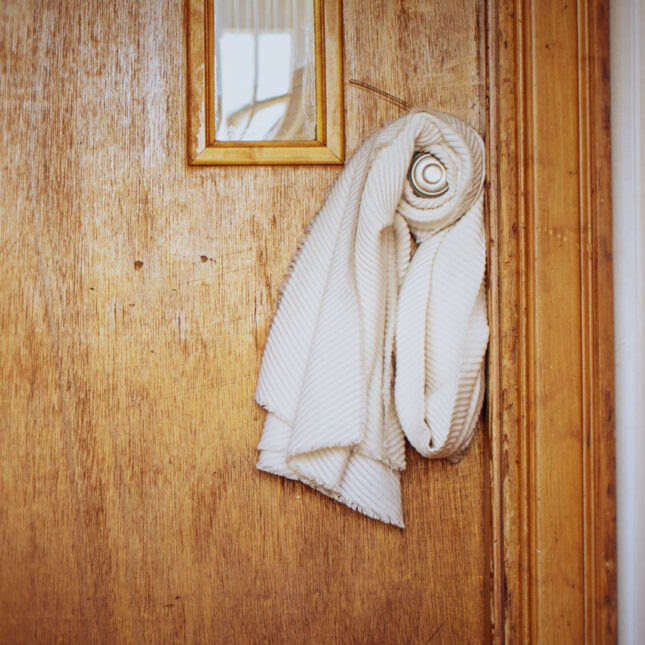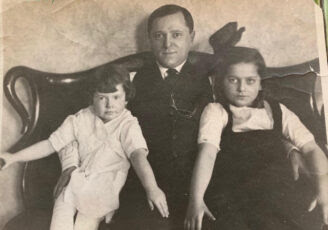By KARA N. GOLDMAN
In 1918, a white scarf tied to the door of my grandmother’s family’s apartment on the North Side of Chicago alerted the community to a virus residing within. My grandmother, then age 3, was one of 500 million people worldwide — one-third of the planet’s population — who was infected with what came to be known as the Spanish influenza. It killed an estimated 50 million people.

The author’s grandmother, Elinor Elisberg, left, sits with her father, Max, and her sister Marcia.
PHOTO COURTESY KARA GOLDMAN
She was quarantined in her room, unable to communicate with the outside world. Her parents and older sister stayed in their apartment, heeding city-wide warnings to avoid exposing others in their community to the disease.

My grandmother could later recall with eerie detail the isolation and the fear, and the image burned into her brain of coffins passing by her window. Neighbors who were healthy one day were dead the next.
Elinor Elisberg Miller survived. She went to college at Northwestern University. She was fascinated by microbiology, likely influenced by her early experiences. She became a biology teacher in Chicago public high schools — though had she grown up a few decades later I’m certain she would have been a doctor. She married a wonderful man, had three children, celebrated the births of three granddaughters, lived to dote on four great-grandkids, celebrated her 100th birthday with beer and hundreds of her closest friends, and passed peacefully at nearly 103 years of age.
Related: Quarantine for coronavirus? Let’s make that unnecessary
My grandmother’s story could have ended differently. She survived to live an incredibly long, full life, as did her sister and parents, because they were smart. As the flu swept through Chicago, they practiced the kind of social distancing and quarantine that is today being actively sanctioned but inadequately implemented. Because of their white scarf and caution, they saved each other and their neighbors, friends, and colleagues, as well as their doctors.
Fast forward to 2020. As Miller’s granddaughter, a physician living with —and working within — today’s pandemic, I find her story compelling and relevant. The average mortality rates for the two pandemics seem to be similar: 2.5% during the 1918 Spanish Flu and between 1.5% and 3% from early estimates of Covid-19. At least for now, the average speed of disease progression appears slower with Covid-19. My grandmother recalled hearing countless stories of healthy individuals who went to work in the morning and never came home.
With Covid-19, many people infected with the novel coronavirus don’t show any symptoms for days. That means there’s no way to tell who in the community is contagious. So the only way to protect yourself and others is by limiting unnecessary contact. Every infection that isn’t spread makes us all safer.
Even though we have had a few months to anticipate the disaster heading toward us, instead of white scarves and massive efforts to protect our neighbors and communities we see spring breakers and tremendous denial. For our health care workforce, a tragic lack of personal protective equipment means that my friends and colleagues are putting their lives on the line without proper protection and reusing the few masks they’ve been able to acquire through their workplace or through personal contacts and social media. In an irony that could never have been predicted 100 years ago as my grandmother’s family placed a white scarf on its doorknob, our healthcare providers are being asked to repurpose bandanas and scarves into homemade masks.
Related: We don’t send soldiers to fight a war without weapons. Give doctors what they need to fight Covid-19
The least each of us can do is take a lesson from generations before us: Stop the spread of Covid-19 by staying home. Do it for yourself, your family, and your neighbors. Do it for the vulnerable: those with cancer or who’ve had organ transplants, those with lung disease, elderly parents and grandparents, pregnant women, and the list goes on.
Do it for those who work in hospitals and who will care for you and your family if you get sick. They will continue to do the jobs they’ve trained for despite the fact that they are at particularly high risk for developing severe cases of Covid-19, even those who are young and healthy. Health care workers like me desperately want to stay healthy so we can continue working and caring for our patients and our families.
Stay home so your grandchild can one day tell the story of this pivotal moment when socially responsible people — like yourself — applied the lessons of those who came before us.
And if you are home with Covid-19, use your time and your voice to advocate for rapid production of personal protective equipment and medical supplies for health care providers. Then tie a white scarf to your door. It doesn’t mean you are giving up. Just the opposite: it means you are fully in the fight and sending a message your community and the world that we are all in this together.
Kara N. Goldman, M.D., is an assistant professor of obstetrics and gynecology at Northwestern University Feinberg School of Medicine.

Leave a Reply